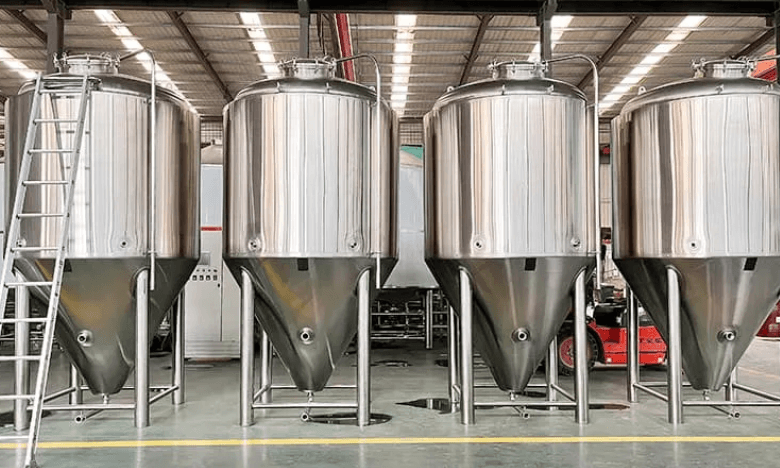Why Stainless Steel Is Preferred for Food Fermentation Tanks

Food fermentation has been practiced for centuries, but modern industrial processes demand equipment that can keep up with today’s safety, quality, and scalability standards. Among all the materials available for constructing fermentation tanks —plastic, glass, ceramic, and stainless steel—stainless steel has emerged as the clear industry favorite. But why is stainless steel preferred for food fermentation tanks across breweries, dairies, pickling plants, and probiotic food manufacturers?
This article explores the reasons behind stainless steel’s dominance, highlighting its hygienic properties, strength, compatibility with modern technology, and cost-effectiveness in the long term.
The Importance of Material Choice in Food Fermentation
In food fermentation, the tank isn’t just a container—it’s part of the process. The material it’s made of affects everything from cleanliness to taste, from batch consistency to equipment lifespan. Unlike beverages like beer or wine, fermented foods (such as yogurt, kimchi, sauerkraut, and kombucha) are sensitive to contamination, pH levels, and temperature fluctuations.
Choosing the wrong material can:
- Lead to corrosion or leaching
- Encourage bacterial contamination
- Cause inconsistencies in fermentation outcomes
- Result in regulatory non-compliance
That’s why material choice is critical—and why stainless steel leads the way.
Stainless Steel’s Corrosion Resistance
One of the most important features of stainless steel is its excellent resistance to corrosion. During fermentation, acidic by-products (like lactic acid, acetic acid, or ethanol) are commonly produced. Many materials degrade in such environments, but stainless steel maintains its integrity over time.
- 304 Stainless Steel: Most commonly used in food-grade tanks. Resistant to corrosion under general fermentation conditions.
- 316 Stainless Steel: Offers enhanced resistance to chlorides and acidic compounds. Often used in applications involving brine or saltwater (e.g., pickles, sauerkraut).
Because of its high chromium and nickel content, stainless steel forms a passive protective layer that resists chemical attack, making it ideal for food fermentation environments.
Sanitary Properties and Easy Cleaning
Cleanliness is non-negotiable in any food production facility. Stainless steel’s non-porous, smooth surface makes it easy to clean and sanitize.
Benefits for Sanitation:
- No microbial harboring: Unlike plastic or wood, stainless steel has no pores where bacteria or mold can hide.
- Compatible with CIP (Clean-In-Place) systems: Stainless steel tanks can be cleaned without disassembly.
- Withstands hot water and caustic cleaning agents: Making it suitable for thorough sanitation cycles.
This hygienic property reduces the risk of cross-contamination between batches and supports compliance with food safety regulations.
Mechanical Strength and Durability
Stainless steel is renowned for its structural strength, which offers several benefits in food-grade tank construction:
- Withstands internal pressure: Essential for carbonation or pressurized fermentation (e.g., kombucha or sparkling wine).
- No risk of cracking or shattering: Unlike glass or some plastics.
- Durable under frequent use and cleaning: It doesn’t degrade with repeated heat or chemical exposure.
- Longevity: A well-maintained stainless steel tank can last 20+ years, making it a solid long-term investment.
For high-volume fermentation, durability directly translates to reliability and lower operational downtime.
Compatibility with Temperature Control Systems
Fermentation requires precise temperature control to ensure the growth of beneficial microbes while preventing spoilage. Stainless steel tanks support advanced cooling and heating systems:
- Jacketed tanks: Allow integration with glycol cooling or steam heating systems
- Thermowells and sensors: Can be welded directly into the tank for real-time temperature monitoring
- Uniform heat distribution: Stainless steel’s conductivity allows consistent temperature across the tank wall
This level of control is crucial in both small-batch artisanal operations and large-scale production facilities.
Regulatory and Certification Compliance
Most food safety authorities around the world—including the FDA (U.S.), EFSA (EU), and CFIA (Canada)—prefer or require stainless steel for food-contact surfaces.
Stainless steel tanks can meet:
- 3-A Sanitary Standards: For dairy and other hygienic applications
- ASME certifications: For pressurized tanks
- CE marking: For European markets
- FDA food-grade compliance: For U.S. operations
This makes stainless steel the easiest path toward passing inspections, securing certifications, and meeting international export standards.
Low Maintenance and Long-Term Cost Efficiency
While stainless steel tanks come with a higher upfront cost than plastic or glass options, they pay off over time:
Long-Term Benefits:
- Lower replacement frequency: Plastic and mild steel tanks often need replacing within 3–5 years
- Reduced contamination incidents: Means fewer product recalls or waste
- Easier cleaning routines: Save labor and sanitation costs
- Resale value: Stainless steel tanks retain value in the secondary equipment market
For operations with long-term plans, stainless steel is the most economical choice in terms of total cost of ownership.
Sustainability and Recyclability
In today’s environmentally-conscious world, stainless steel also scores points for sustainability:
- 100% recyclable: Stainless steel is one of the most recycled materials in the world
- Does not leach microplastics or chemicals: Ensures clean waste disposal
- Energy efficient: With proper insulation and cooling design, stainless steel tanks reduce energy loss
These properties help producers meet sustainability goals and support green certifications.
Applications Across Food Fermentation Industries
Stainless steel fermentation tanks are widely used in a range of industries:
1. Brewery & Distillery
Used for beer, kombucha, mead, and distilled spirit fermentation
2. Dairy Production
Yogurt, kefir, and cheese benefit from sanitary stainless vessels with temperature control
3. Vegetable Fermentation
Kimchi, sauerkraut, and pickles require corrosion-resistant tanks to handle acidic brines
4. Probiotic Beverages
Kombucha, kvass, and other live cultures rely on pressurized, sanitary tanks to maintain microbiological integrity
5. Industrial Food Manufacturing
Larger food producers use stainless steel tanks for sourdough starters, miso, soy sauce, and more
Why Micet Offers the Best Stainless Steel Fermentation Tanks
When selecting a tank manufacturer, it’s crucial to work with a supplier that specializes in sanitary design, customization, and compliance. That’s where Micet stands out.
Micet’s Stainless Steel Advantages:
- 304/316L food-grade stainless steel with polished sanitary finishes
- Custom sizes and configurations tailored to your product
- Supports CIP, jacketed cooling, and advanced fittings
- Globally certified with CE, ASME, and 3-A compliance
- Long service life with minimal maintenance
From small kombucha startups to industrial-scale sauerkraut producers, Micet has delivered durable, hygienic, and cost-effective fermentation solutions worldwide.
FAQs
Q1: Can stainless steel affect the taste of fermented food?
No. Stainless steel is non-reactive and does not alter the flavor, aroma, or nutritional profile of fermented foods.
Q2: Is stainless steel safe for probiotic fermentation?
Yes. Its smooth, non-porous surface reduces contamination risk, making it ideal for live cultures used in probiotic beverages or yogurt.
Q3: How long do stainless steel fermentation tanks last?
With proper cleaning and maintenance, stainless steel tanks can last 20 years or more, making them a durable and reliable investment for any food processing facility.
